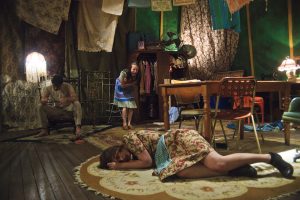The Criminals
 |
| Photo by Lucy Parakhina |
The Old 505 Theatre presents THE CRIMINALS by Jose Triana (translated by Adrian Mitchell) at the Old 505 Theatre, Hibernian House, Elizabeth St, Central Railway.
THE CRIMINALS (La Noche de los Asesinos -The Night of the Assassins) by Jose Triana, has been translated by Adrian Mitchell. Apparently there are two versions of the play written by Mr Triana, a Cuban writer. The first in 1957 whilst the writer was living in Spain during the time of the Cuban revolution against Fulgencio Batista. The second in 1965 after he had returned to Cuba and was part of the “artistic and intellectual communities surrounding Fidel Castro”. The text was revised. It had now a reduced cast of three, and shifted the style into an “absurd ritual” and according to the programme notes from this production – became “a more sober examination of a world after victory … Triana’s Cubans are post-traumatic, post-utopian and post-radical – a community undergoing in Triana’s own words, a ‘collective schizophrenia’ …”
A surviving ‘family’ of young adults, Lalo (David Valencia), Cuca (Rosanna Easton) and Beba (Emily Morrison) act out a series of ritualised games about the murder of parents. Fictive or non-fictive, a future plan or a remembered action, we never clearly know. A sense of a traumatic need to discover a basis to behave permeates the content of the play and stretches the relationships of the characters into shifting alliances. It reminded me of the ritual games of some of Jean Genet’s work: THE MAIDS (1947), THE BALCONY (1957) and THE SCREENS (1964). Like this play, they too, seemed to exist, as a result of huge cultural turmoil resulting in a primal search for a new way of behaving and identity. This is not a familiar Australian dilemma.
I am not sure whether this translation is dated or whether, more simply, the content of the play and it’s methods, just do not have relevant cultural resonance or urgency for me. This production may have sprung from the passion of identification that Mr Valencia may have to the original material, he being of a Latin American background (Colombian), and the persuading of the director, James Dalton, to its potential for a contemporary Sydney audience, but, I remained mostly coolly aloof from the story telling and its consequences.
Another reason for this company to choose this text is the opportunities for acting that the writer has resolved. Mr Valencia as Lalo, the brother, certainly seizes the material, and has a clear and powerful vision (identification, perhaps) of what the play is saying and is particularly mesmerising. His work is imbued with possessed passion that mounts to a climatic monologue of transfixing immediacy. Ms Morrison as Beba, the ‘sister’ with less to say, also, when given the opportunity, focuses our attention – her ‘Spanish’ is connected and palpable in its performance effect. On the other hand Ms Easton as Caca, seems to be in another world other than the one the other actors are dealing with and does not really connect or build her performance with or from them. The performance only ‘appears’ to be present with the other characters but is really, on analysis, a solo turn. It is dynamic and confident but disassociated from the shown activity that the other two actors attempt to communicate to her and to us.
The performance I saw then did not have a concerted cohesion. Only two of the performing energies are focused on the storytelling, the writer’s intentions, and so, the play falters under the absence of the other ‘pillar’ of the structure. This lack of ensemble causes the set up moments of Mr Dalton’s production to be unclear and the modus operandi of the style of the play and the joint collusion of intent of these characters is not filtered to us until well into the playing time, where writerly reiteration conveys that knowledge. Sadly, by that time one was out of caring for the people of the play, and, rather, intent on analyzing why was this so.
The design in this intimate space by Emma Kingsbury and Dylan Tonkin is beguiling with its balance of a Cuban colour palette (greens, orange), and a profligate weight of found furniture and prop objects that created believably a world of scavenged looting – a world of chaos and catch-what-catch-can. Atmospheric.
It is interesting to have the opportunity to see this writer’s work and be invited to participate in a Latin American story and milieu. I recommend the production with that in mind and to see the flair of a very arresting imagination and skill in Mr Valencia’s work and the obvious intelligence and theatrical care of the director, Mr Dalton.